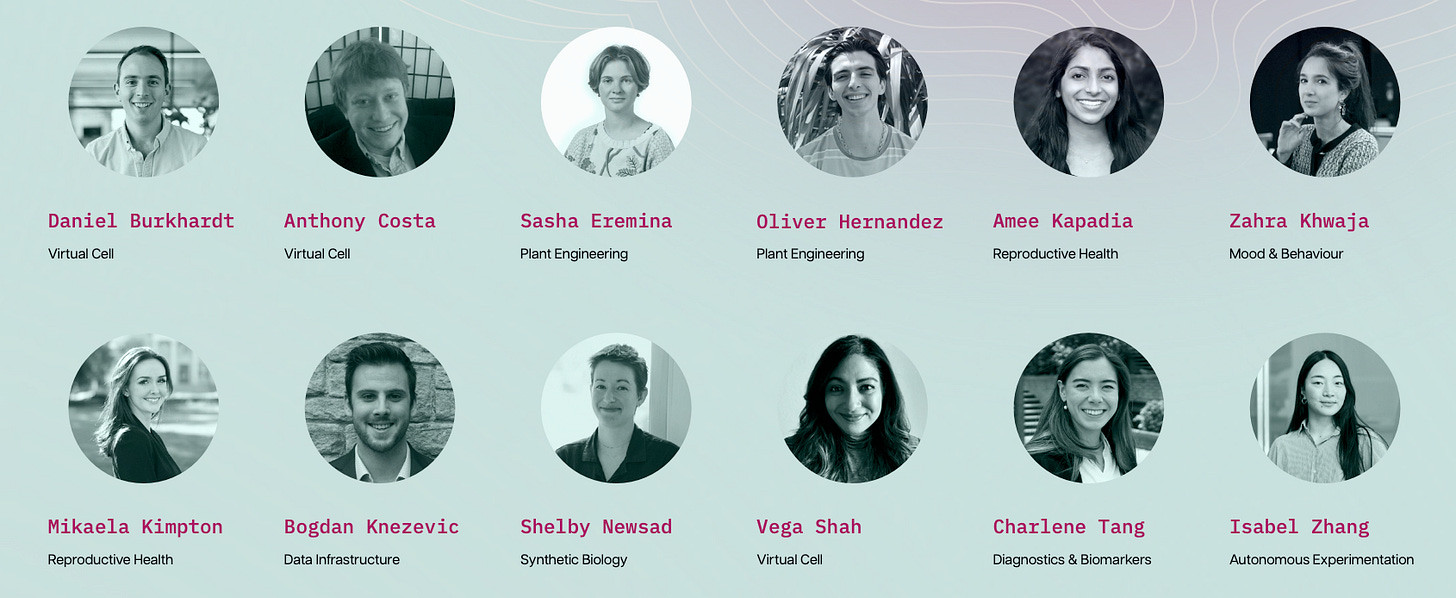Projections at the Frontier: Decoding Bio Snapshot 2025
We delve into seven emerging areas of biotech and chart a course from where we stand today to an envisioned landscape of 2030
Welcome to Decoding Bio’s BioByte: each week our writing collective highlight notable news—from the latest scientific papers to the latest funding rounds—and everything in between. All in one place.
Decoding Bio Snapshot 2025
Led and organized by Zahra Khwaja
AI is no longer a tool in the background. It is everywhere, increasingly automating not only our tasks but also functions that once demanded human thought and decision-making. As more of what we used to make, analyze, and even imagine becomes automated, the danger is clear: a world where creation itself is outsourced.
That is why human creativity and curiosity matter more than ever. Breakthroughs will not come from recycling what already exists online, but from imagining futures that don’t yet exist, and charting the paths to reach them. The signal from the noise will emerge through careful imagining, disciplined planning, and the courage to explore what others haven’t yet dared.
Each year, the Decoding Bio community produces a Snapshot of technology’s present and its emerging themes. This year’s edition takes a different shape: instead of a retrospective, it is a forward-looking exercise in imagination. Every theme is cast as a projection toward 2030, grounded in the realities of 2025.
We ask:
What future do we want to see in 2030?
Where are we standing in 2025?
What must change to bridge the gap?
Which challenges will define the journey?
Who is already pioneering the way forward?
In this way, the 2025 Snapshot is both a record and a springboard: a clear-eyed view of today, and a map of possibilities for the decade ahead in biology and technology.
This year’s report highlights several critical areas at the intersection of AI and biology:
AI-Based Virtual Cell Models Drive Discovery & Preclinical Testing
By 2030, virtual cells, digital twins of human cells, could revolutionize the way we do biology. If current efforts are successful, instead of directly testing every idea in the lab, researchers could first use these virtual cells to simulate different scenarios and focus on the ones most likely to lead to fundamental discoveries and safer therapeutics. These models would mimic the behavior of real cells, helping to speed up both basic research and the development of new treatments. Scientists have been working toward building a virtual cell since the early 2000s, but initial efforts have been focused on single-celled microbes. The combination of massive multi-omics datasets and a golden era of molecular modeling tools is finally making it possible to build something that lives up to the promise of simulating human biology.
Autonomous Experimentation: The Future of Biological Discovery
By 2030, fully integrated robotics, hardware, and software will autonomously design, execute, and analyze experiments across modalities and cellular systems. This will seamlessly link research labs to pharma workflows, transforming discovery, scale-up, and manufacturing into a continuous, data-driven process that operates 24/7/365 without human bottlenecks. It represents a fundamental shift in the scientific method—from episodic, human-driven testing to continuous, data-driven exploration—exemplified by initiatives such as the King Lab’s “Robot Scientists” Adam, Eve, and the upcoming Genesis system, and by companies like Lila Sciences and Intrepid Labs that are building AI-powered autonomous labs.
Proactive, Predictive, and Personalized Diagnostics & Biomarkers
By 2030, individuals will have affordable, real-time access to their biomarker profiles and actionable insights, shifting healthcare toward earlier intervention and tighter disease-management loops. A market shift—where consumers increasingly demand ownership of their health data—is driving the rise of integrated, multimodal platforms that combine advanced diagnostics with wearables and AI-driven analytics for predictive, preventive, personalized, and participatory healthcare.
Unified Data Infrastructure in Biotech
By 2030, biotech companies will leverage unified data infrastructure to gain unprecedented real-time research and development (R&D) awareness, informing every major decision and rapidly cutting R&D costs and time-to-market. This transformation will allow scientific leaders to tap into their “data ocean” and apply emerging AI models to dramatically reduce cycle time in drug development, leading to faster results, earlier milestones, and new funding opportunities.
Plant Engineering for Consumer-Tailored Food and Sustainable Materials
By 2030, precise interfacing with native plant genomes will enable faster iteration and better predictions of field performance, leading to a surge of consumer-aimed traits such as improved palatability, convenience, and bespoke nutritional content. At the same time, growers will benefit from elevated plant health and increased climate adaptability. Moving beyond slow and cumbersome breeding processes, precise editing of plant genomes will elicit desired functions and behaviors, with existing examples ranging from nutrient-enhanced tomatoes to glowing petunias.
Mood and Behavior Regulation through AI-Driven Neuro-Coaches
By 2030, AI-driven neuro-coaches, integrated with everyday devices, will continuously interpret brain and physiological data to provide dynamic behavioral interventions. Individuals will be empowered to optimize mood, creativity, and overall cognitive resilience on a daily basis. This vision anticipates a “brain thermostat” for emotional balance, potentially alleviating mental-health burdens at scale.
Reproductive Health Transformation through IVG and Advanced Genomic Screening
By 2030, clinicians will routinely use in vitro gametogenesis (IVG) and advanced genomic screening to help prospective parents assess embryo health and fertility potential, transforming fertility care from reactive interventions to proactive, choice-driven planning. This convergence promises to expand access to genetically related children for those previously excluded from biological parenthood and to enable screening for a broader range of genetic traits and disease risks, shifting fertility care toward a more intentional, data-informed process.
Thank you to all the authors and Bunsen for designing everything in the Snapshot.
Did we miss anything? Would you like to contribute to Decoding Bio by writing a guest post? Drop us a note here or chat with us on Twitter: @decodingbio.








